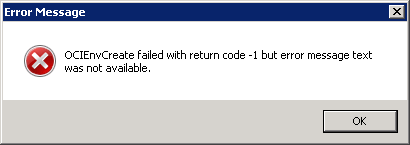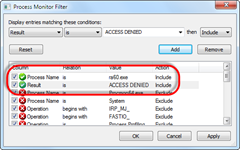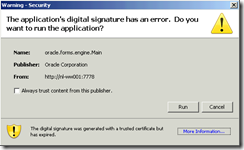Remko Weijnen's Blog (Remko's Blog)
About Virtualization, VDI, SBC, Application Compatibility and anything else I feel like
Archive for the ‘Packaging’ Category
Application Compatibility Fixing to the Extreme?
Author: Remko Weijnen23 May
Today’s blog is about an application that was migrated to Citrix XenApp. During testing the users reported that several application menu’s were missing.
An example is the settings menu where the System tab is missing:
| Fat Client: | XenApp: |
![clip_image002[5] clip_image002[5]](https://www.remkoweijnen.nl/blog/wp-content/uploads/2013/05/clip_image0025_thumb.jpg) |  |
I suspected a permissions issue so I added the account to the Local Administrator group to verify that. And indeed the System tab was visible.
Process Monitor
I removed the account from the Administrators group and fired up Process Monitor. I set a filter on the process name (ra60.exe) and on Result (ACCESS DENIED):
Harmony Client crashes upon exit
Author: Remko Weijnen31 Jan
Today I was troubleshooting the application “Harmony Client” which crashed upon exiting:
The application had been thinapped and the error only appeared when starting the thinapped version.
Error 372 in Thinapped Visual Basic Application
Author: Remko Weijnen3 Jan
![]() Today I was troubleshooting a Thinapped Visual Basic Application. The application halts with a Run-time error ‘372’ when trying to run a report:
Today I was troubleshooting a Thinapped Visual Basic Application. The application halts with a Run-time error ‘372’ when trying to run a report:
Microsoft KB article kb942870 hints to an ActiveX component that is registered into HKCU instead of HKLM.
A trace with the ThinApp Log Monitor reveals that the application is looking for an ActiveX component under HKCU:
Kofax VRS Unattended Install
Author: Remko Weijnen18 Jan
Recently I needed to create an Unattended Install for an application that uses a piece of software (for scanning) called Kofax VRS.
This Kofax software comes with an .msi file but there was no documentation on the install options.
In fact it didn’t seem like the Vendor anticipated on an Unatttended Install.
I browsed in the msi file using Microsoft’s Orca tool and tried some of the properties I found in the public properties table.
Another packaging challenge
Author: Remko Weijnen17 Jan
Another post on something that happened last week, this time it’s about a Java based Application again.
This particular application wanted to download three DLL’s from the Webserver to the Java bin directory.
This presents us with several issues on a multi user server such as a Citrix of Terminal Server:
- The user does not have write permissions in this directory
- If we we give the user write permissions here what happens when the DLL’s are in use by another user?
I assumed that if I preinstalled the DLL’s the application wouldn’t try to overwrite them but that didn’t work.
Then I monitored with Process Monitor if the Application wrote some kind of check file but at first I didn’t find anything.
So I decided to use the CorrectFilePaths shim to redirect the DLL’s to the user’s homedirectory (see Using the CorrectFilePaths shim to redirect an ini file to a writable location for an explanation).
Troubleshoot CorrectFilePath shim
Author: Remko Weijnen16 Jan
A few days ago I was packaging an application that was writing an INI file in the application directory.
If you have read my earlier article, Using the CorrectFilePaths shim to redirect an ini file to a writable location, then you will probably think: create a nice shim and redirect that ini file!
But this application had a few challenges, the first being that it writes %COMPUTERNAME%.INI. The application’s developer probably assumed that a user is bound to one pc and that no other user’s use that pc.
To solve it we we need to catch all possible computer names (it would be nice if the CorrectFilePaths shims was able to accept wildcards and environment variables).
But it doesn’t so it means we have to add a parameter for each possible computer name. In my case that was doable because I have only 8 Citrix servers.
So I created a Fix using the Application Compatibility Manager as described in my previous post.
However it didn’t work, so I started to trace what happens.
Java Webapplication, certificates and Citrix
Author: Remko Weijnen11 Jan
Yesterday I created an Unattended Installation of a webapplication. Of course it was “just a web link” and the application vendor usually says: you don’t need to install it just go the URL and that’s it.
The reality is usually that you go to the URL and need to install several (ActiveX) components and maybe other dependencies such as Java.
While a user may have the permissions for this on his own pc, on a Citrix or Terminal Server environment this is highly unlikely.
So we need to package and pre-install this for the users.
Nothing special so far but this particular application had some special things that were interesting enough to blog about.
So let’s start with what happened, I visited the URL of an application called Centric Key 2 Financien.
First I got a few popups with Certificates that needed to be accepted:
The application’s instructions say that the user must accept this and set the “Always trust content from this publisher” checkbox.
Fixing Applications: The Next Step
Author: Remko Weijnen7 Jan
Lately I wrote a few articles about fixing bad applications using Compatibility Shims. If you didn’t read them yet, here are the links:
I also described that you can install an Application Compatibility Database using the sdbinst command.
At first I just took a script task in my Altiris Server to deploy the database using sdbinst -q <dbname> but later on I got a better idea.
Another Oracle Error
Author: Remko Weijnen7 Jan
My collegue that is working with me on the current project was packaging another application that uses Oracle.
The interesting thing about it is that he ran into the same error I did: the Oracle client tries to create (and access) an Object in the Global namespace.
But he got an entirely different error message:

To confirm it was the same issue I gave a test user the Create Global Objects privilege and after logging on again the problem went away.
So I applied the same fix that I wrote about yesterday in Redirect Global Object to Local Objects (aka fix that bad app!) to this application and it worked nicely!
Redirect Global Object to Local Objects (aka fix that bad app!)
Author: Remko Weijnen6 Jan
Today I was working on Unattended Installation of an Application called SmartDocuments.
The application seemed to behave nicely on a Multi User (Citrix/Terminal Server) environment: it writes user configuration to the user part of the registry and writes configuration files in a user accessible path.
When testing with a normal user account I ran into a problem though, I got an Oracle ORA-01019 error message:
The English message is ORA01019: unable to allocate memory in the user side.
Profile
Top Posts
- Query Active Directory from Excel
- RNS 510 Startup Logo–My thoughts
- Adding a hidden Exchange mailbox to Outlook
- How rdp passwords are encrypted
- Get Actual CPU Clock Speed with PowerShell
- ClickOnce Applications in Enterprise Environments
- VW RNS 510 Navigation Startup Pictures
- Unattended Installation of IBM System i Access for Windows
- Reading physical memory size from the registry
- Show Client IP Address when using NetScaler as a Reverse Proxy
Recent Comments
Featured Downloads
- AClientFix (13595 downloads )
- AddPrinter2.zip (12854 downloads )
- AdProps (12379 downloads )
- AdSample1 (11432 downloads )
- AMD Radeon Crimson ReLive (29847 downloads )
- Atheros Driver (34019 downloads )
- AutoLogonXP 1.0 (11404 downloads )
- CDZA (9560 downloads )
- ChDrvLetter.zip (11217 downloads )
- ChDrvLetter.zip (14356 downloads )
Blogroll
- Andrew Morgan
- Arnout’s blog
- Assa’s Blog
- Barry Schiffer
- Delphi Praxis
- Ingmar Verheij
- Jedi Api Blog
- Jedi API Library
- Jeroen Tielen
- Kees Baggerman
Categories
- .NET (4)
- Active Directory (28)
- Altiris (36)
- App-V (1)
- Apple (5)
- Application Compatibility (11)
- Automotive (5)
- AWS (1)
- BootCamp (1)
- C# (6)
- C++ (2)
- Citrix (87)
- Delphi (61)
- Embedded (4)
- Exchange (16)
- General (71)
- iPhone (5)
- Java (8)
- Linux (1)
- Lync (2)
- NetScaler (1)
- Oracle (4)
- Other (1)
- Packaging (19)
- PowerShell (56)
- Programming (79)
- Quest (1)
- RES (7)
- script (22)
- ShareFile (1)
- SQL Server (10)
- Strange Error (3)
- Terminal Server (68)
- ThinApp (3)
- ThinKiosk (1)
- Ubuntu (1)
- Unattended Installation (19)
- Uncategorized (51)
- UWP (2)
- Vista (37)
- Visual Studio (1)
- VMWare (26)
- Windows 10 (2)
- Windows 2003 (30)
- Windows 2008 (37)
- Windows 2008 R2 (16)
- Windows 2012 (2)
- Windows 7 (30)
- Windows 8 (4)
- Windows Internals (12)
- Windows XP (16)
Archives
- February 2023 (1)
- October 2022 (3)
- July 2022 (1)
- June 2022 (2)
- October 2019 (1)
- March 2018 (1)
- January 2018 (4)
- December 2017 (3)
- April 2017 (1)
- March 2017 (5)
- February 2017 (4)
- May 2016 (3)
- March 2016 (1)
- October 2015 (2)
- September 2015 (1)
- January 2015 (1)
- August 2014 (1)
- July 2014 (8)
- May 2014 (1)
- November 2013 (1)
- October 2013 (2)
- September 2013 (3)
- August 2013 (4)
- June 2013 (2)
- May 2013 (3)
- April 2013 (5)
- March 2013 (5)
- February 2013 (1)
- January 2013 (5)
- December 2012 (9)
- November 2012 (3)
- October 2012 (3)
- August 2012 (4)
- July 2012 (2)
- June 2012 (1)
- May 2012 (6)
- March 2012 (13)
- February 2012 (12)
- January 2012 (9)
- December 2011 (9)
- November 2011 (4)
- October 2011 (5)
- September 2011 (10)
- August 2011 (10)
- July 2011 (2)
- June 2011 (8)
- May 2011 (12)
- April 2011 (4)
- March 2011 (14)
- February 2011 (8)
- January 2011 (32)
- December 2010 (23)
- November 2010 (19)
- October 2010 (10)
- September 2010 (6)
- August 2010 (1)
- July 2010 (1)
- June 2010 (6)
- March 2010 (7)
- February 2010 (3)
- December 2009 (3)
- November 2009 (11)
- September 2009 (2)
- July 2009 (1)
- June 2009 (5)
- May 2009 (1)
- April 2009 (2)
- March 2009 (3)
- February 2009 (6)
- January 2009 (3)
- December 2008 (8)
- November 2008 (5)
- October 2008 (3)
- September 2008 (3)
- August 2008 (3)
- June 2008 (6)
- May 2008 (2)
- April 2008 (3)
- March 2008 (5)
- January 2008 (3)
- December 2007 (3)
- November 2007 (13)
- October 2007 (10)





